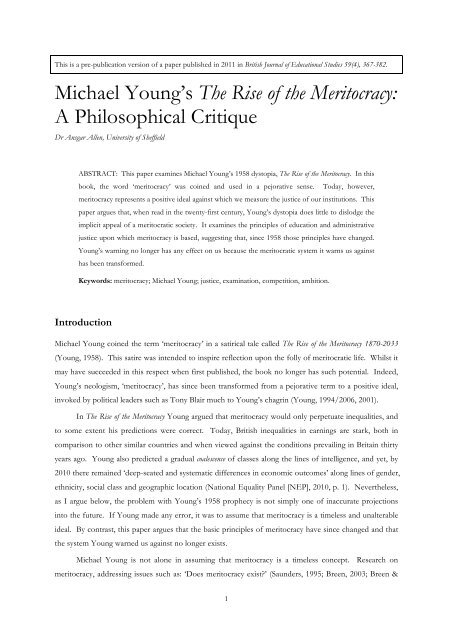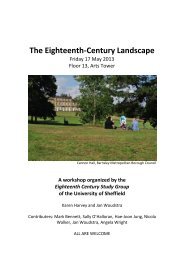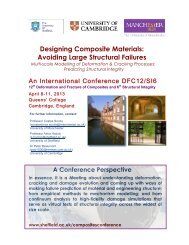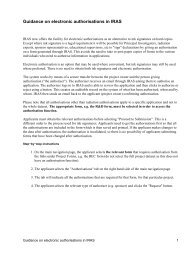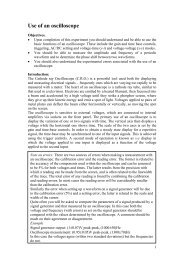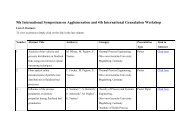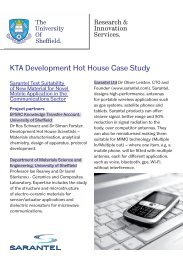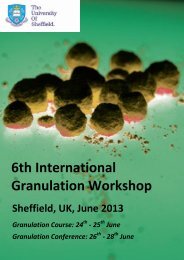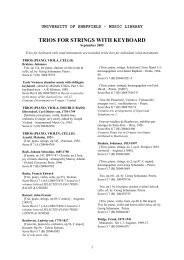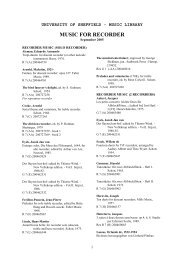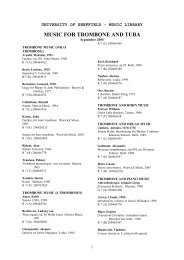Michael Young's The Rise of the Meritocracy - University of Sheffield
Michael Young's The Rise of the Meritocracy - University of Sheffield
Michael Young's The Rise of the Meritocracy - University of Sheffield
Create successful ePaper yourself
Turn your PDF publications into a flip-book with our unique Google optimized e-Paper software.
This is a pre-publication version <strong>of</strong> a paper published in 2011 in British Journal <strong>of</strong> Educational Studies 59(4), 367-382.<br />
<strong>Michael</strong> Young’s <strong>The</strong> <strong>Rise</strong> <strong>of</strong> <strong>the</strong> <strong>Meritocracy</strong>:<br />
A Philosophical Critique<br />
Dr Ansgar Allen, <strong>University</strong> <strong>of</strong> <strong>Sheffield</strong><br />
ABSTRACT: This paper examines <strong>Michael</strong> Young’s 1958 dystopia, <strong>The</strong> <strong>Rise</strong> <strong>of</strong> <strong>the</strong> <strong>Meritocracy</strong>. In this<br />
book, <strong>the</strong> word ‘meritocracy’ was coined and used in a pejorative sense. Today, however,<br />
meritocracy represents a positive ideal against which we measure <strong>the</strong> justice <strong>of</strong> our institutions. This<br />
paper argues that, when read in <strong>the</strong> twenty-first century, Young’s dystopia does little to dislodge <strong>the</strong><br />
implicit appeal <strong>of</strong> a meritocratic society. It examines <strong>the</strong> principles <strong>of</strong> education and administrative<br />
justice upon which meritocracy is based, suggesting that, since 1958 those principles have changed.<br />
Young’s warning no longer has any effect on us because <strong>the</strong> meritocratic system it warns us against<br />
has been transformed.<br />
Keywords: meritocracy; <strong>Michael</strong> Young; justice, examination, competition, ambition.<br />
Introduction<br />
<strong>Michael</strong> Young coined <strong>the</strong> term ‘meritocracy’ in a satirical tale called <strong>The</strong> <strong>Rise</strong> <strong>of</strong> <strong>the</strong> <strong>Meritocracy</strong> 1870-2033<br />
(Young, 1958). This satire was intended to inspire reflection upon <strong>the</strong> folly <strong>of</strong> meritocratic life. Whilst it<br />
may have succeeded in this respect when first published, <strong>the</strong> book no longer has such potential. Indeed,<br />
Young’s neologism, ‘meritocracy’, has since been transformed from a pejorative term to a positive ideal,<br />
invoked by political leaders such as Tony Blair much to Young’s chagrin (Young, 1994/2006, 2001).<br />
In <strong>The</strong> <strong>Rise</strong> <strong>of</strong> <strong>the</strong> <strong>Meritocracy</strong> Young argued that meritocracy would only perpetuate inequalities, and<br />
to some extent his predictions were correct. Today, British inequalities in earnings are stark, both in<br />
comparison to o<strong>the</strong>r similar countries and when viewed against <strong>the</strong> conditions prevailing in Britain thirty<br />
years ago. Young also predicted a gradual coalescence <strong>of</strong> classes along <strong>the</strong> lines <strong>of</strong> intelligence, and yet, by<br />
2010 <strong>the</strong>re remained ‘deep-seated and systematic differences in economic outcomes’ along lines <strong>of</strong> gender,<br />
ethnicity, social class and geographic location (National Equality Panel [NEP], 2010, p. 1). Never<strong>the</strong>less,<br />
as I argue below, <strong>the</strong> problem with Young’s 1958 prophecy is not simply one <strong>of</strong> inaccurate projections<br />
into <strong>the</strong> future. If Young made any error, it was to assume that meritocracy is a timeless and unalterable<br />
ideal. By contrast, this paper argues that <strong>the</strong> basic principles <strong>of</strong> meritocracy have since changed and that<br />
<strong>the</strong> system Young warned us against no longer exists.<br />
<strong>Michael</strong> Young is not alone in assuming that meritocracy is a timeless concept. Research on<br />
meritocracy, addressing issues such as: ‘Does meritocracy exist?’ (Saunders, 1995; Breen, 2003; Breen &<br />
1
Goldthorpe, 2001), ‘Can it be achieved?’ (Goldthorpe, 1997, 2003), and, more rarely, ‘Is it desirable?’<br />
(<strong>The</strong>melis, 2008), tends to adopt a relatively static conception <strong>of</strong> meritocracy itself. In <strong>the</strong> research<br />
literature, and in everyday discourse, meritocracy takes <strong>the</strong> form <strong>of</strong> an abstract ideal against which one can<br />
judge <strong>the</strong> present imperfection <strong>of</strong> a particular society. According to this universal viewpoint, a just society<br />
must be, amongst o<strong>the</strong>r things, a meritocratic one. And so, <strong>the</strong> discovery <strong>of</strong> systematic differences, such<br />
as those mentioned in <strong>the</strong> paragraph above, is said to violate ‘fundamental principles <strong>of</strong> social justice’<br />
(NEP, 2010, p. 3). More than this, such unfairness is also viewed as a source <strong>of</strong> social ill health. As<br />
Harriet Harman, <strong>the</strong> former Minister for Women and Equality writes; we must challenge unfairness ‘for<br />
<strong>the</strong> sake <strong>of</strong> a strong and meritocratic economy and to achieve a peaceful and cohesive society’ (NEP,<br />
2010, p. iii). <strong>Meritocracy</strong> as an abstract ideal is also a measure <strong>of</strong> progress, where more advanced societies<br />
are held to be those that are more meritocratic. <strong>The</strong>y make fewer decisions based on prejudice and<br />
extend opportunity fur<strong>the</strong>r. <strong>Meritocracy</strong> is sometimes used as a measure <strong>of</strong> corruption, where corrupt<br />
societies or corrupt institutions are thought to be those that disobey <strong>the</strong> formula: merit = ability + effort.<br />
Meritocratic societies are open and fair, non-meritocratic ones are obscure and underhand. Justice, social<br />
cohesion, progress, fairness and transparency, <strong>the</strong>se are <strong>the</strong> timeless ideas upon which meritocracy is<br />
presumed to rest.<br />
This paper aims to deconstruct such notions through a philosophical critique <strong>of</strong> <strong>the</strong> more<br />
historically specific principles upon which Young’s book was based. <strong>The</strong> aim is to take Young’s<br />
predictions seriously in order to measure <strong>the</strong> distance between <strong>the</strong>n and now, to show that meritocracy<br />
operated according to a very different rationality in 1958. Young constructed <strong>the</strong> logical set <strong>of</strong><br />
consequences as he saw <strong>the</strong>m half a century ago. Accordingly, he predicted a slow reorganisation and<br />
<strong>the</strong>n gradual solidification <strong>of</strong> classes, based increasingly on merit ra<strong>the</strong>r than descent. This would<br />
eventually bring about a rigidly stratified society, divided according to intelligence alone. Of course, this<br />
kind <strong>of</strong> highly administered society has not been achieved. Instead, individuals are encouraged to seek<br />
personal improvement ra<strong>the</strong>r than wait for <strong>the</strong> state to reward individual effort and assist in <strong>the</strong><br />
reallocation <strong>of</strong> social position. <strong>The</strong> situation today is closer to <strong>the</strong> system implied by <strong>the</strong> rhetoric <strong>of</strong><br />
<strong>Michael</strong> Gove, Secretary <strong>of</strong> State for Education, who demanded that <strong>the</strong> United Kingdom should work<br />
towards becoming an “aspiration nation” (House <strong>of</strong> Commons, 24 November 2010). This point is<br />
developed in <strong>the</strong> accompanying White Paper, which explains that as citizens we must administer ourselves<br />
so that we become <strong>the</strong> ‘authors <strong>of</strong> our own life stories’ (Department for Education, 2010, p. 6). <strong>The</strong><br />
demand for administrative overview has been replaced by <strong>the</strong> demand for ambition, and, as I argue below,<br />
this is part <strong>of</strong> an overall transition that has changed <strong>the</strong> principles <strong>of</strong> meritocracy almost beyond<br />
recognition.<br />
<strong>The</strong> <strong>Rise</strong> <strong>of</strong> <strong>the</strong> <strong>Meritocracy</strong>: a brief synopsis<br />
From <strong>the</strong> distant perspective <strong>of</strong> 2033, Young’s narrator reflects back to <strong>the</strong> 1960s and 1970s and recalls<br />
<strong>the</strong> eventual defeat <strong>of</strong> those who supported comprehensive reform. This defeat was a victory for <strong>the</strong><br />
2
meritocrats who, according to Young, were quick to argue that ‘sentimental egalitarianism’ would only<br />
ever encourage ‘mediocrity’ (Young, 1958, pp. 32-3). In his account, stronger partitioning and greater<br />
compulsion followed <strong>the</strong> failure <strong>of</strong> comprehensive schooling. Able pupils were paid a maintenance<br />
allowance to keep <strong>the</strong>m in education while less able pupils were encouraged to leave. Grammar schools<br />
were improved until <strong>the</strong>y outclassed and replaced private schools. Most importantly, intelligence tests<br />
were developed and extended as <strong>the</strong> primary administrative machinery.<br />
<strong>The</strong> continuity <strong>of</strong> psychometric science was secured through a direct appeal to <strong>the</strong> unique ability <strong>of</strong><br />
this science to correlate high IQ with high performance in grammar school. This circumvented more<br />
thorny issues over whe<strong>the</strong>r intelligence actually exists or not as a general entity within <strong>the</strong> mind. <strong>The</strong><br />
methods seemed to work, and this was all that mattered. Eventually <strong>the</strong> predictive potential <strong>of</strong><br />
intelligence testing was perfected. From this technocratic perspective, comprehensive schooling was only<br />
appropriate in a more uncertain age when selection at eleven was less scientific. Under <strong>the</strong>se conditions a<br />
certain amount <strong>of</strong> fluidity ‘actually did some good by making it easier for people to swim from one stream<br />
to ano<strong>the</strong>r’ (Young, 1958, p. 59). From <strong>the</strong> late 1980s onwards, this sort <strong>of</strong> fluidity was no longer<br />
appropriate as a higher degree <strong>of</strong> precision in making allocations was now possible. Intelligence was<br />
measured every five years in order to check predictions and effect small corrections, and yet, with time<br />
even this procedure would be abandoned. Gradually, predictions made during childhood became so<br />
accurate that regular retesting throughout life was dropped (even though some argued it should be<br />
retained ‘if only to maintain <strong>the</strong> morale <strong>of</strong> low-I.Q. subjects who would o<strong>the</strong>rwise be without hope’). ‘In<br />
2000, <strong>the</strong> reliable age was 9; in 2015, <strong>the</strong> reliable age was 4; in 2020 it was 3’ (Young, 1958, p. 143). <strong>The</strong><br />
entire course <strong>of</strong> education from nursery to university could be divided into a hierarchy <strong>of</strong> progression<br />
routes, each beginning in infancy. Segregation according to intelligence would now be complete.<br />
<strong>The</strong> old institutional model <strong>of</strong> protracted and incremental workplace promotion - from floor<br />
cleaner to executive in twenty years - was also gradually abandoned. As industry began to recognise that<br />
recruits at 15 or 16 could no longer work <strong>the</strong>ir way up through <strong>the</strong> company (being now <strong>of</strong> a uniformly<br />
inferior intelligence), higher positions were recruited for directly from those attending higher education.<br />
Whilst, direct recruitment such as this was an advance on <strong>the</strong> old model <strong>of</strong> workplace promotion, it<br />
never<strong>the</strong>less resulted in hectic competition. Companies descended upon grammar schools and<br />
universities in order to scout for <strong>the</strong> best brains, siphoning <strong>the</strong>m <strong>of</strong>f before <strong>the</strong>ir education was complete<br />
with <strong>the</strong> promise <strong>of</strong> generous salaries. At this stage in meritocratic development, competition was at best<br />
a necessary evil, one that must remain subordinate to <strong>the</strong> well-planned distributive ideal. Eventually,<br />
highly administered societies obviate <strong>the</strong> need for competition: ‘Effective brain power planning is not<br />
only necessary to end one <strong>of</strong> <strong>the</strong> kinds <strong>of</strong> competition between employers that is wasteful, but gives <strong>the</strong><br />
government strategic power to control <strong>the</strong> whole economy’ (Young, 1958, p. 67). Competition was only<br />
required in early meritocracy to motivate individuals so that <strong>the</strong>y would work to redistribute <strong>the</strong>mselves:<br />
‘Before modern society could reach maturity, ambition had to be forced ever upwards’ (Young, 1958,<br />
3
p. 102). Once meritocratic society reached maturity, excessive (unreasonable) ambition became a<br />
dangerous condition.<br />
Despite <strong>the</strong> gradual perfection <strong>of</strong> administrative machinery, <strong>the</strong>re never<strong>the</strong>less existed seeds <strong>of</strong><br />
social discontent within <strong>the</strong> explicit distributive justice <strong>of</strong> <strong>the</strong> new order. In previous times, individual<br />
economic and social fate could be blamed upon circumstance. ‘Educational injustice enabled people to<br />
preserve <strong>the</strong>ir illusions, inequality <strong>of</strong> opportunity fostered <strong>the</strong> myth <strong>of</strong> human equality’ (Young, 1958,<br />
p. 85). “If only my life had been different, I would have been rewarded, I would be in a different<br />
situation” was <strong>the</strong> old lament. In early meritocracy it was possible to blame circumstance and not oneself.<br />
This resulted in a strange sort <strong>of</strong> inner peace, a type <strong>of</strong> personal contentment that persisted alongside calls<br />
for greater equality. <strong>The</strong> old system was “unjust” because it was unjustly unequal.<br />
In <strong>the</strong> new more advanced meritocracy, social position was <strong>the</strong> direct expression <strong>of</strong> ability + effort,<br />
a formula that was objectively defined and completely explicit. Individuals had to accommodate<br />
<strong>the</strong>mselves to <strong>the</strong> fact that <strong>the</strong>ir social status was a direct expression <strong>of</strong> <strong>the</strong>ir intellectual worth. <strong>The</strong><br />
system was now “just” because it was justly unequal. We are told that imaginations were still haunted by<br />
<strong>the</strong> narrative <strong>of</strong> Huxley’s gammas and Orwell’s proles. Yet, people began to realise that <strong>the</strong>se horror-<br />
stories were <strong>the</strong> mere irrational outbursts <strong>of</strong> an earlier age. <strong>The</strong>y were unreasonable attacks upon social<br />
conditioning, attacks that were written for a different era; <strong>the</strong>se social critiques had no relevance in a well-<br />
administered meritocratic state. <strong>Meritocracy</strong>, Young’s narrator asserts, had become increasingly and<br />
unassailably just. ‘Enlightened modern methods have nothing in common with <strong>the</strong>se brave new worlds<br />
[<strong>of</strong> Huxley and Orwell]’. To ‘square efficiency with justice, and order with humanity, was nothing less<br />
than a new stage in <strong>the</strong> ascent <strong>of</strong> man, brought within his reach by <strong>the</strong> early advances in <strong>the</strong> social<br />
sciences’ (Young, 1958, p. 92).<br />
As <strong>the</strong> narrator’s account draws to a close we find that this new stage in <strong>the</strong> ascent <strong>of</strong> man is,<br />
never<strong>the</strong>less, under threat. Social unrest is on <strong>the</strong> increase, and as we are to discover, revolution is near.<br />
It seems that <strong>the</strong> ascent <strong>of</strong> man was destined to falter, for apparent justice is at times harder to bear than<br />
injustice, and this is a situation that, if left unchecked, will lead <strong>the</strong> less intelligent classes to revolt. <strong>The</strong><br />
account breaks <strong>of</strong>f and a footnote tells us that <strong>the</strong> narrator and author was killed in <strong>the</strong> upheavals <strong>of</strong><br />
May 2034.<br />
<strong>The</strong> principles <strong>of</strong> meritocracy in 1958<br />
To readers <strong>of</strong> <strong>the</strong> twenty-first century this is an odd tale. It was intended as a warning: “This is where<br />
meritocracy could lead us!” Of course, this warning was clearly <strong>of</strong>f target, as <strong>the</strong> society Young foresaw<br />
was never even remotely achieved. And yet, it would be a mistake to dismiss <strong>the</strong> book entirely.<br />
Important lessons can be gained from <strong>the</strong> very distance that lies between Young’s imagined future and<br />
subsequent events. His dystopia is instructive precisely for what it failed to predict. <strong>The</strong> fact that<br />
Young’s inevitable future was not borne out in reality suggests that meritocratic logics underwent<br />
transformation and took ano<strong>the</strong>r path. Four historically contingent principles <strong>of</strong> meritocracy can be<br />
4
extracted from his account: (1) <strong>Meritocracy</strong> requires administrative overview and <strong>the</strong> careful redistribution<br />
<strong>of</strong> human ability. (2) For administrative purposes, human ability is a relatively fixed trait. (3) Competition<br />
is irrational and is to be avoided. (4) A perfected meritocracy is one where inequalities are precisely<br />
matched to abilities. It is a society where inequalities are justly unequal.<br />
For <strong>the</strong> remainder <strong>of</strong> this paper I treat each principle <strong>of</strong> meritocracy in turn. I show, very briefly,<br />
how each principle reflects broader social processes and assumptions in and before 1958, and <strong>the</strong>n cast<br />
doubt on <strong>the</strong> endurance <strong>of</strong> each principle between 1958 and <strong>the</strong> present.<br />
1) <strong>Meritocracy</strong> requires administrative overview and <strong>the</strong> careful redistribution <strong>of</strong> human ability.<br />
<strong>The</strong> idea <strong>of</strong> administering <strong>the</strong> distribution <strong>of</strong> ability (and replacing patronage) can be traced back to<br />
Jeremy Bentham’s Constitutional Code <strong>of</strong> 1830. This detailed programme for <strong>the</strong> organisation <strong>of</strong><br />
government contains <strong>the</strong> tedious details <strong>of</strong> a so-called ‘System <strong>of</strong> Official Location’ to be used in<br />
allocating <strong>of</strong>ficial posts. By <strong>the</strong> combination <strong>of</strong> question book, tickets, ticket board, cylindrical box and<br />
non-discerning child (who would choose <strong>the</strong> questions to be asked), candidates for governmental posts<br />
would be examined and <strong>the</strong>n delivered to <strong>the</strong>ir respective positions. Examination would bring candidates<br />
straight to <strong>the</strong>ir post, in a way that maximised human resources and minimised cost (Bentham, 1830).<br />
This was a highly mechanistic and novel system that sought to replace <strong>the</strong> vagaries <strong>of</strong> patronage with <strong>the</strong><br />
precision <strong>of</strong> scientific allocation. In practice, patronage was first challenged in <strong>the</strong> Indian Civil Service<br />
when examinations were introduced in 1854, and in <strong>the</strong> Home Civil Service somewhat later in 1870<br />
(Roach, 1971).<br />
At a similar time, and following <strong>the</strong> pioneering work <strong>of</strong> Francis Galton (1869), <strong>the</strong> distribution <strong>of</strong><br />
human abilities throughout <strong>the</strong> population was put in question. Galton suggested that <strong>the</strong> range <strong>of</strong><br />
mental power is ‘enormous’, and yet, when you place men ‘according to <strong>the</strong>ir natural abilities’ in ‘classes<br />
separated by equal degrees <strong>of</strong> merit’, <strong>the</strong> number <strong>of</strong> men in each class is far from equal (Galton, 1869,<br />
p. 26). Indeed, according to Galton, <strong>the</strong> distribution <strong>of</strong> ability follows a pattern which we now refer to as<br />
a normal or bell-shaped distribution. This population level awareness was an innovation at <strong>the</strong> time<br />
(Porter, 1986). Combined with <strong>the</strong> above efforts in <strong>the</strong> civil service to replace patronage and ensure that<br />
<strong>the</strong> best man got <strong>the</strong> job, this awareness <strong>of</strong> human ability and its distribution throughout <strong>the</strong> population<br />
suggested that all vocations might be administered in a similar way.<br />
2) For administrative purposes, human ability is a relatively fixed trait.<br />
<strong>The</strong> history <strong>of</strong> intelligence testing is complex (for a recent study see White, 2006). Yet, an overall<br />
transition can be observed from an early twentieth century preoccupation with <strong>the</strong> role <strong>of</strong> genetic traits,<br />
to a mid to late twentieth century emphasis on environmental factors and <strong>the</strong>ir effect on mental<br />
development. <strong>The</strong> early association between intelligence and genetics reflects <strong>the</strong> initial connection<br />
between efforts to measure intelligence and eugenic thought, from Galton’s early attempts to quantify<br />
mental energy (Galton, 1885) to later work by psychologists sympa<strong>the</strong>tic to <strong>the</strong> eugenic cause (e.g.<br />
5
Goddard, 1914; Terman, 1919). Meanwhile, Charles Spearman (1904) advanced a <strong>the</strong>ory <strong>of</strong> intelligence<br />
that suggested it was a unitary and measurable phenomenon (he labelled this supposed entity ‘g’).<br />
<strong>The</strong> redistribution <strong>of</strong> human ability makes most obvious sense when ability is viewed as<br />
determined at birth. However, this genetic hypo<strong>the</strong>sis was severely challenged following <strong>the</strong> fallout <strong>of</strong><br />
World War II (see for example <strong>the</strong> statement issued by <strong>the</strong> United Nations Educational, Scientific and<br />
Cultural Organization, 1952). Moreover, <strong>the</strong> idea that intelligence could be represented as a single entity<br />
had always been a contested <strong>the</strong>ory. And yet, despite such doubts, in Young’s dystopia one finds that<br />
intelligence testing is portrayed as dominant and unquestioned. This perhaps unlikely result is, Young<br />
explains, due to <strong>the</strong> predictive facility <strong>of</strong> testing. In <strong>The</strong> <strong>Rise</strong> <strong>of</strong> <strong>the</strong> <strong>Meritocracy</strong>, <strong>the</strong> proven utility <strong>of</strong><br />
intelligence testing in predicting future success (tautological as this may be) ensures <strong>the</strong> ongoing survival<br />
<strong>of</strong> psychometric techniques against any rising doubts over <strong>the</strong> exact nature <strong>of</strong> intelligence itself. In<br />
isolation, scientific doubt poses an insufficient challenge to <strong>the</strong> use <strong>of</strong> such instruments when <strong>the</strong>ir utility<br />
is demanded by <strong>the</strong> logic <strong>of</strong> meritocratic repositioning. Under conditions such as <strong>the</strong>se it could be<br />
assumed for administrative purposes that intelligence is reasonably fixed even if this assumption is open<br />
to challenge from a scientific perspective.<br />
3) Competition is irrational and is to be avoided.<br />
As P J Hartog explained in his 1911 lecture, Examinations in <strong>the</strong>ir bearing on national efficiency, it is important<br />
to be clear about <strong>the</strong> precise function <strong>of</strong> examinations that are used ‘to distinguish between candidates <strong>of</strong><br />
different merit’ (Hartog, 1918, p. 6). <strong>The</strong> ‘competitive idea’ that lingers behind notions <strong>of</strong> advance by<br />
merit can, he claimed, lead us into confusion because <strong>the</strong> idea <strong>of</strong> competition can tempt us ‘to forget <strong>the</strong><br />
distinction between <strong>the</strong> efficiency <strong>of</strong> an examination and its difficulty’ (Hartog, 1918, p. 7). Very difficult<br />
examinations are likely to be highly competitive, but are <strong>the</strong>y efficient? According to Hartog, an efficient<br />
examination is one that says something useful about those who pass it. This means that superior<br />
examinations are not simply those which are harder to pass. ‘<strong>The</strong> main question is, surely, not which<br />
candidate can do <strong>the</strong> most difficult things, solve <strong>the</strong> most Chinese <strong>of</strong> puzzles, remember <strong>the</strong> most<br />
unrememberable <strong>of</strong> formulae’ (Hartog, 1918, p. 7). Ra<strong>the</strong>r, superior examinations are those devices that<br />
match people to tasks and are able to divide candidates who can perform certain pre-defined social<br />
functions from those who cannot. In <strong>the</strong> field <strong>of</strong> administrative efficiency <strong>the</strong> competitive principle is<br />
inappropriate and potentially damaging.<br />
<strong>The</strong> psychologist Cyril Burt went fur<strong>the</strong>r, suggesting that competition is also associated with<br />
irrational drives. He railed against systems <strong>of</strong> vocational guidance where ‘<strong>the</strong> predominating element in<br />
<strong>the</strong> choice <strong>of</strong> occupation is <strong>the</strong> wish or <strong>the</strong> whim <strong>of</strong> <strong>the</strong> parent and <strong>of</strong> <strong>the</strong> child’ (Burt, 1924, p. 339).<br />
Irrational motivations include ‘selfish’ desires for a ‘quick financial return’, potentially misplaced though<br />
‘fond ambitions’, ‘gossip’ and ‘fantasies’. <strong>The</strong> average parent also suffers from a ‘lack <strong>of</strong> psychological<br />
insight’ and ‘cannot possibly have <strong>the</strong> range <strong>of</strong> information necessary for a satisfactory choice’ (Burt, 1924,<br />
p. 339). Teachers <strong>of</strong>ten fill this gap <strong>of</strong> expertise but ‘<strong>the</strong> teacher is an educational not an industrial expert:<br />
and <strong>of</strong> all <strong>the</strong> pr<strong>of</strong>essions his [sic] is perhaps <strong>the</strong> least in contact with <strong>the</strong> world <strong>of</strong> business’ (Burt, 1924,<br />
6
p. 340). According to Burt, a centralised administrative machinery making use <strong>of</strong> precise and rational<br />
techniques was required.<br />
Closer in time to <strong>the</strong> writing <strong>of</strong> Young’s dystopia, <strong>the</strong>se anti-competitive principles can be<br />
observed in <strong>the</strong> efforts that were made to confine grammar school examinations (GCEs) to grammar<br />
school children (see Brooks, 2008). Indeed, in <strong>the</strong> early post-war years, some educationalists felt that<br />
external examinations were fundamentally inappropriate for secondary modern schools. It was seen as<br />
‘impracticable to combine a system <strong>of</strong> external examinations, which presupposes a measure <strong>of</strong> uniformity,<br />
with <strong>the</strong> fundamental conception <strong>of</strong> modern school education, which insists on variety’ (Ministry <strong>of</strong><br />
Education, 1947, p. 46). In this context, one general examination, open to a vast range <strong>of</strong> pupils, would<br />
invite undue competitive effort. It was felt, by contrast, that examinations should be ‘qualifying ra<strong>the</strong>r<br />
than competitive’ (Montgomery, 1965, p. 142). According to this logic, only grammar schools with<br />
relatively homogenous populations (in terms <strong>of</strong> <strong>the</strong>ir intelligence) could withstand a single, external<br />
examination. In <strong>the</strong> grammar school, examination would be a qualifying procedure ra<strong>the</strong>r than a<br />
competitive device for siphoning upper streams <strong>of</strong> ability from a vast range <strong>of</strong> candidates.<br />
<strong>The</strong> overall post-war model for secondary schooling, according to which after examination at<br />
eleven-plus pupils would be allocated to ei<strong>the</strong>r grammar, technical or modern schools also eschewed <strong>the</strong><br />
competitive principle. In this context, it was argued that ‘parity <strong>of</strong> schools in <strong>the</strong> secondary stage <strong>of</strong><br />
education’ was ‘essential’ (Board <strong>of</strong> Education, 1938, p. 293). Equal status would ‘make it easier to<br />
transfer pupils to schools better suited to <strong>the</strong>ir needs’ without ‘creating any sense <strong>of</strong> slur or failure’ (Board<br />
<strong>of</strong> Education, 1938, p. 168). <strong>The</strong> ‘legacies <strong>of</strong> an age which had a different educational and social outlook<br />
from our own’, that gave ‘certain schools a prestige’ based on ‘o<strong>the</strong>r than educational grounds’ must be<br />
swept away. Once established, equality <strong>of</strong> status will ensure that all schools are ‘equally acceptable to<br />
parents’ and will enable allocations to those that will ‘best develop’ <strong>the</strong> ‘particular abilities’ <strong>of</strong> <strong>the</strong>ir<br />
children (Board <strong>of</strong> Education, 1938, p. 293). This ideal <strong>of</strong> parity was repeated in fur<strong>the</strong>r reports (Board<br />
<strong>of</strong> Education, 1943; Ministry <strong>of</strong> Education, 1947). <strong>The</strong> socialist MP and Minister <strong>of</strong> Education Ellen<br />
Wilkinson was also a staunch supporter. She claimed that a differentiated array <strong>of</strong> schooling is necessary<br />
in order to accommodate <strong>the</strong> range <strong>of</strong> human aptitude. Indeed, whatever we do to our education system,<br />
‘coal’ will still have ‘to be mined and fields ploughed’. What has to be removed, simply, is <strong>the</strong> ‘fantastic<br />
idea’ that ‘you are in a higher social class if you add up figures in a book’ ra<strong>the</strong>r than tend <strong>the</strong> land<br />
(Wilkinson 1946 cited in McCulloch, 1998, p. 62). Meritocratic administration, it seems, requires a certain<br />
amount <strong>of</strong> parity when it comes to <strong>the</strong> esteem in which jobs are held, to make sure that <strong>the</strong> population at<br />
large accepts its human redistributions. Vast inequalities <strong>of</strong> status are undesirable in this context merely<br />
because <strong>the</strong>y invite undue competition.<br />
<strong>The</strong> subordinate position given to competition can be observed in Young’s account where<br />
companies were at first allowed to descend on grammar schools and universities in order to scout for <strong>the</strong><br />
best brains. However, as ‘brain power planning’ was perfected, this mode <strong>of</strong> vocational positioning came<br />
to be seen as ‘wasteful’ (Young, 1958, p. 67). Competition, it appears, was only necessary in earlier, more<br />
7
poorly administered times. Once administrative perfection was attained, <strong>the</strong> irrational drives <strong>of</strong> ambition<br />
were no longer required. Individuals would no longer be relied upon to redistribute <strong>the</strong>mselves.<br />
4) A perfected meritocracy is one where inequalities are precisely matched to abilities.<br />
Following Galton’s extension <strong>of</strong> <strong>the</strong> statistical ‘law <strong>of</strong> error’ to human phenomena, resulting in <strong>the</strong> normal<br />
distribution (MacKenzie, 1981, p. 57), it was now possible to conceive <strong>of</strong> administering a human<br />
population according to its normally distributed traits. Soon after <strong>the</strong> invention <strong>of</strong> intelligence testing,<br />
Goddard (1914) classified <strong>the</strong> various grades <strong>of</strong> ‘feeble-minded’ according to <strong>the</strong>ir industrial capacity.<br />
Burt (1924) extended this principle to <strong>the</strong> entire population, suggesting that vocations were also normally<br />
distributed. It remained merely to match <strong>the</strong> bell-shaped distribution <strong>of</strong> human abilities to this normal<br />
distribution <strong>of</strong> jobs (see figure 1).<br />
Figure 1. A Hierarchy <strong>of</strong> Occupations and <strong>the</strong> Normal Distribution <strong>of</strong> <strong>the</strong>ir Employments (Burt 1924: 349)<br />
Acting as a sorting mechanism, schooling would also divide itself according to <strong>the</strong> normal distribution.<br />
Grammar and technical schools were to take <strong>the</strong> upper section <strong>of</strong> ability, modern schools would take <strong>the</strong><br />
vast bulk <strong>of</strong> average and below average pupils, and special schools would take <strong>the</strong> remainder[1].<br />
Eventually, when an external examination (<strong>the</strong> CSE) designed to suit <strong>the</strong> needs <strong>of</strong> <strong>the</strong> modern school was<br />
introduced, it was intended to cater for <strong>the</strong> upper end <strong>of</strong> modern school ability (see figure 2).<br />
8
Figure 2. Proposed ability range for GCE and CSE examinations (Ministry <strong>of</strong> Education 1963b: 4)<br />
It should be noted that <strong>the</strong> CSE was not intended for <strong>the</strong> entire modern school population. It was to be a<br />
qualifying examination catering for a specific band <strong>of</strong> <strong>the</strong> normal distribution. <strong>The</strong> division <strong>of</strong> pupil<br />
populations at eleven, followed by streaming or setting in secondary schooling, and completed by an<br />
appropriate qualifying examination at <strong>the</strong> end <strong>of</strong> schooling aimed to achieve a precise match between<br />
qualifications and abilities. Overall, <strong>the</strong> differentiated provision <strong>of</strong> secondary education, <strong>the</strong><br />
administration <strong>of</strong> qualifying examinations and <strong>the</strong> distribution <strong>of</strong> jobs was designed with a normally<br />
distributed population in mind.<br />
<strong>The</strong> principles <strong>of</strong> meritocracy since 1958<br />
Young explains how, as meritocracy matures, it graduates from administrative imperfection to a state that<br />
is increasingly just in its allocations. In an imperfect or newly established meritocracy, competition and<br />
ambition are to be allowed if not encouraged, so that genius can promote itself to <strong>the</strong> position it deserves.<br />
When meritocratic administration is perfected and all members <strong>of</strong> <strong>the</strong> population are correctly allocated<br />
according to <strong>the</strong>ir position within <strong>the</strong> normal distribution, competition and ambition are no longer<br />
necessary. Indeed, excessive ambition could lead members <strong>of</strong> <strong>the</strong> population to interfere with <strong>the</strong> finely<br />
tuned allocations <strong>of</strong> advanced meritocracy. This “inevitable” historical progression is what allows Young<br />
to reach his apocalyptic conclusion: A society that is justly unequal invites rebellion in a way that an unjustly<br />
unequal society does not. <strong>The</strong> transparency <strong>of</strong> administrative systems in advanced meritocracy provides an<br />
obvious target for revolt, especially when compared to <strong>the</strong> indeterminate and multiple forces <strong>of</strong> ill fortune<br />
that prevail in a less perfected meritocratic society. So, as Young appears to suggest, <strong>the</strong> principles <strong>of</strong><br />
meritocracy are in <strong>the</strong> end self-defeating. Life for those fur<strong>the</strong>r down <strong>the</strong> normal distribution in advanced<br />
meritocratic societies is intolerable, whilst <strong>the</strong> target for revolt is clear and explicit.<br />
Young’s mistake was to assume that meritocracy is a universal ideal. In <strong>the</strong> early twenty-first<br />
century, British society far from resembles <strong>the</strong> apocalyptic predictions <strong>of</strong> his book, precisely because <strong>the</strong><br />
principles <strong>of</strong> meritocracy have changed. According to my argument, administrative justice was <strong>the</strong> major<br />
“casualty” <strong>of</strong> this transition. In his 1954 study <strong>of</strong> social mobility, <strong>the</strong> sociologist David Glass makes some<br />
interesting and prescient observations in this respect. Concerned with <strong>the</strong> social consequences <strong>of</strong><br />
perfected human sorting, Glass (1954, p. 25) argues that <strong>the</strong> ‘existence <strong>of</strong> opportunity to rise in status’<br />
according to ability might lessen feelings ‘<strong>of</strong> personal frustration’ and bring about ‘greater social harmony’.<br />
<strong>The</strong> knowledge that we live within a system that allows us to realise our talents is seen as good for social<br />
stability. It produces contentment or at least, it avoids discontent. Glass (1954, p. 25) <strong>the</strong>n makes a<br />
ra<strong>the</strong>r mischievous observation, suggesting that ‘even if <strong>the</strong>re is little actual opportunity to rise in social<br />
status, <strong>the</strong> belief in a myth <strong>of</strong> opportunity may produce similar results’. As argued below, this switch<br />
from <strong>the</strong> administration <strong>of</strong> movement to a belief in movement did take place, forming one important aspect<br />
in <strong>the</strong> overall transformation <strong>of</strong> meritocracy. Social opportunity was indeed mythologised in this way.<br />
9
This switch from administration to belief occurred when a perfect match between <strong>the</strong> normal distribution<br />
<strong>of</strong> ability and <strong>the</strong> normal distribution <strong>of</strong> jobs no longer formed <strong>the</strong> aim <strong>of</strong> (<strong>the</strong> adjusted) meritocratic logic.<br />
<strong>The</strong> principles <strong>of</strong> meritocracy instead became internalised into <strong>the</strong> practices <strong>of</strong> aspiring social subjects.<br />
In a separate observation, Glass suggests that technical perfection in <strong>the</strong> assessment procedure<br />
could also breed discontent. Selection procedures that divide <strong>the</strong> population into deliberate streams<br />
would reinforce <strong>the</strong> prestige <strong>of</strong> certain occupations. <strong>The</strong> ‘feeling <strong>of</strong> resentment [this would engender]<br />
may be more ra<strong>the</strong>r than less acute’ because ‘apparent justice may be more difficult to bear than injustice’<br />
(Glass, 1954, p. 26). This formula, we should observe, is <strong>the</strong> principle that lies behind <strong>the</strong> social unrest<br />
and subsequent death <strong>of</strong> <strong>the</strong> narrator in Young’s dystopia. Once a system <strong>of</strong> merit displays itself as<br />
increasingly just in its allocations, <strong>the</strong> situation actually becomes harder to bear (when related to one’s<br />
personal lack <strong>of</strong> success) than was <strong>the</strong> unjust system that preceded it. Here, Glass develops a point made<br />
a decade earlier by <strong>the</strong> economist Friedrich Hayek in his critique <strong>of</strong> highly administered societies. When<br />
‘<strong>the</strong> position <strong>of</strong> an individual’ is no longer determined by ‘impersonal forces’, ‘<strong>the</strong> attitude <strong>of</strong> <strong>the</strong> people<br />
towards <strong>the</strong>ir position in <strong>the</strong> social order necessarily changes’ (Hayek, 1944, p. 79). ‘Dissatisfaction <strong>of</strong><br />
everybody with his lot will inevitably grow with <strong>the</strong> consciousness that it is <strong>the</strong> result <strong>of</strong> deliberate human<br />
decision’ (Hayek, 1944, p. 80). Again, we see in this observation <strong>the</strong> possibility <strong>of</strong> an alternative system.<br />
A system that operated according to an explicit (though ultimately unrealised) attempt to achieve justice<br />
in <strong>the</strong> distribution <strong>of</strong> ability would later be replaced. <strong>The</strong> system that followed it would leave questions <strong>of</strong><br />
overall distributive justice behind, thus avoiding <strong>the</strong> just/unjust dichotomy.<br />
To make a detailed case for this overall transition demands more space than is available here, and<br />
so for <strong>the</strong> remainder <strong>of</strong> this paper only <strong>the</strong> brief outlines <strong>of</strong> a broader cultural shift can be suggested.<br />
This will be achieved by showing how each <strong>of</strong> <strong>the</strong> above principles (1-4) may have been inverted leading<br />
to a very different meritocratic arrangement. <strong>The</strong> adjusted principles <strong>of</strong> contemporary meritocracy can be<br />
summarised as follows: (1) <strong>Meritocracy</strong> no longer requires detailed administrative intervention. (2) Human<br />
ability is seen as malleable. (3) Competition within meritocracy is to be encouraged. (4) A perfect<br />
distribution <strong>of</strong> abilities is no longer required.<br />
1) <strong>Meritocracy</strong> without detailed administrative intervention.<br />
<strong>The</strong> move away from detailed administrative intervention is connected with changing modes <strong>of</strong><br />
governance. Over <strong>the</strong> last quarter century <strong>the</strong> practice <strong>of</strong> government has moved increasingly away from<br />
direct intervention and towards a mode <strong>of</strong> steering from a distance. In this new climate, citizens are<br />
encouraged to take greater responsibility for <strong>the</strong>ir lives as <strong>the</strong> state withdraws[2]. <strong>The</strong> consequences for<br />
meritocracy are pr<strong>of</strong>ound. In this revised political climate, direct human repositioning finds little support<br />
as politicians are now keen to avoid <strong>the</strong> accusation <strong>of</strong> “social engineer”[3]. Instead, individuals must take<br />
up <strong>the</strong> task <strong>of</strong> repositioning <strong>the</strong>mselves. In this context, personal ambition is essential.<br />
10
2) Human ability is malleable.<br />
Despite a certain degree <strong>of</strong> resistance amongst those who believe intelligence is largely determined at birth<br />
(see Jensen, 1969; Herrnstein, 1973; Eysenck, 1973; Herrnstein & Murray, 1994), <strong>the</strong> consensus seems to<br />
be that intelligence is reasonably malleable, if not multiple (see Gardner, 1983). This makes <strong>the</strong> business<br />
<strong>of</strong> meritocratic repositioning far more complicated than when intelligence is seen as fixed, unitary and<br />
determined. Never<strong>the</strong>less, it could be assumed, for administrative purposes at least as was outlined above,<br />
that human ability is relatively fixed and measurable. However, this assumption no longer fits with <strong>the</strong><br />
dominant meritocratic logic that depends upon <strong>the</strong> perceived malleability <strong>of</strong> its subjects. Current<br />
meritocracy requires so-called ‘mastery children’ (more below) who ‘believe that you can improve your<br />
intelligence’ if you try (Weeden et al, 2002, p. 53). Only those who believe <strong>the</strong>y can perpetually improve,<br />
can be depended upon to make <strong>the</strong> constant effort to reposition <strong>the</strong>mselves that is required once <strong>the</strong><br />
social engineer retreats. Individuals must now attend to <strong>the</strong>ir own social mobility.<br />
3) Competition is to be encouraged.<br />
In Young’s advanced meritocracy, competition was to be avoided. This view reflected <strong>the</strong> spirit <strong>of</strong> his<br />
time where competition between schools, for example, was to be deplored[4]. In <strong>the</strong> early post-war years,<br />
variations in school esteem were considered to be a limiting factor that would interfere with<br />
administrative efforts to distribute children amongst schools according to <strong>the</strong>ir ability, and tailor<br />
schooling to <strong>the</strong>ir aptitudes. Once schooling was provided for all, so <strong>the</strong> logic went, competition would<br />
become an unnecessary evil and would have to be removed by achieving parity. This anti-competitive<br />
system looks odd to us now because we are familiar with a very different approach. In <strong>the</strong> second half <strong>of</strong><br />
<strong>the</strong> twentieth century, esteem was transformed from a limiting factor to be levelled at all costs, to a<br />
principle <strong>of</strong> organisational enhancement, pitting schools against each o<strong>the</strong>r as <strong>the</strong>y compete for high<br />
league-table ranking. Competition has long since emerged from its formerly subordinate position, and<br />
now operates at an individual as well as institutional level.<br />
According to some, recent trends in teaching and examination have sought to remove competition<br />
between individuals, ra<strong>the</strong>r than encourage it (Phillips, 1997). <strong>The</strong> rise in formative assessment may seem<br />
to be a case in point, where <strong>the</strong> use <strong>of</strong> qualitative feedback aims to replace ranking and numerical grades.<br />
According to Paul Black and Dylan Wiliam (who raised <strong>the</strong> pr<strong>of</strong>ile <strong>of</strong> formative assessment with <strong>the</strong>ir<br />
widely circulated report Inside <strong>the</strong> black box), as an educational technique formative assessment is designed<br />
to replace a system ‘where <strong>the</strong> classroom culture focuses on rewards, ‘gold-stars’, grades or place-in-<strong>the</strong>-<br />
class ranking’. This makes ‘pupils look for <strong>the</strong> ways to obtain <strong>the</strong> best marks ra<strong>the</strong>r than at <strong>the</strong> needs <strong>of</strong><br />
<strong>the</strong>ir learning’. It also generates a ‘fear <strong>of</strong> failure’ and leads to efforts by pupils to ‘try to build up <strong>the</strong>ir<br />
self-esteem in o<strong>the</strong>r ways’. We are told that, on <strong>the</strong> contrary, what ‘is needed is a culture <strong>of</strong> success,<br />
backed by <strong>the</strong> belief that all can achieve’ (Black & Wiliam, 1998, pp. 8-9). This does not, however,<br />
remove competition from <strong>the</strong> classroom. Though confrontations with failure are to be avoided, this<br />
approach poses no challenge to competition itself, which thrives on optimism. As a more recent<br />
textbook on formative assessment makes clear, formative assessment encourages competitive practices,<br />
11
albeit in a carefully regulated form. ‘Helpless children’ who tend to avoid challenge, believing <strong>the</strong>y will<br />
fail, are to be transformed through formative techniques into ‘mastery children’ who are ‘confident <strong>of</strong><br />
success, believing <strong>the</strong>y can do it if <strong>the</strong>y try’ (Weeden et al., 2002, pp. 53-5). This is to be achieved by<br />
constructing a classroom environment employing pedagogic techniques that allow pupils to ‘learn how to<br />
communicate with <strong>the</strong>ir peers in non-judgemental ways’ (Weeden et al., 2002, p. 89). Pupils are trained in<br />
<strong>the</strong> techniques <strong>of</strong> benevolent and cooperative rivalry, where <strong>the</strong>y peer-assess and self-assess in order to<br />
develop <strong>the</strong>ir powers <strong>of</strong> self-analysis and self-enhancement. Competition does not disappear within <strong>the</strong><br />
explicitly constructive and encouraging ethic <strong>of</strong> formative assessment. What retreats is <strong>the</strong> goad <strong>of</strong><br />
ranking. In its place pupils learn how to enhance process and develop <strong>the</strong>mselves in apparent harmony<br />
with one o<strong>the</strong>r, each involved in personal formative cycles, occupied in unison within individual<br />
feedback-action loops. <strong>The</strong>y learn to become industrious self-improvers, accepting and implementing<br />
external goals. Competition is humanised and disguised and <strong>the</strong>refore intensified by this formative<br />
technology.<br />
4) A perfect distribution <strong>of</strong> abilities is no longer required.<br />
Once individuals are made responsible for <strong>the</strong>ir own meritocratic repositioning (after all, human ability is<br />
now seen as too malleable and complex in its formation to be administered by <strong>the</strong> social engineer),<br />
aspiration is to be encouraged in a context <strong>of</strong> competitive rivalry. A perfect distribution <strong>of</strong> abilities is no<br />
longer seen as feasible nor is it required. This would demand a form <strong>of</strong> administrative intervention that<br />
no longer finds favour with systems <strong>of</strong> power. When individuals are made responsible for <strong>the</strong>ir own<br />
meritocratic repositioning, only an approximation <strong>of</strong> meritocratic perfection can be achieved. <strong>The</strong>re is no<br />
longer any desire to manufacture a social machinery that will perfectly align <strong>the</strong> normal distribution <strong>of</strong><br />
intelligence found within a population alongside a normal distribution <strong>of</strong> educational provision and a<br />
normal distribution <strong>of</strong> jobs.<br />
<strong>The</strong> current meritocratic logic is perhaps best symbolised by a study published in 2010 and<br />
awarded <strong>the</strong> Ig Nobel Prize later that year, an award that celebrates so-called improbable truths. It was<br />
reported that random job promotion is <strong>the</strong> best and most effective form <strong>of</strong> progression in large<br />
bureaucratic organisations (Pluchino et al., 2010). This is just <strong>the</strong> sort <strong>of</strong> research finding that one might<br />
expect to be celebrated in a system where <strong>the</strong> logic <strong>of</strong> scientific administration has been replaced by <strong>the</strong><br />
more fragmented and capricious logic <strong>of</strong> ambition and competitive rivalry. A perfect distribution <strong>of</strong><br />
individuals according to <strong>the</strong>ir relative ability is now felt to be unattainable. Whilst patronage still remains<br />
unthinkable, chance and self-promotion fill <strong>the</strong> gap to become <strong>the</strong> principles <strong>of</strong> meritocratic society.<br />
Conclusion<br />
In this paper, <strong>the</strong> principles <strong>of</strong> meritocracy contained within <strong>Michael</strong> Young’s 1958 dystopia have been<br />
extracted and briefly explored. A deliberate attempt has been made to treat with <strong>the</strong> seriousness <strong>the</strong>y<br />
deserve, <strong>the</strong> more outlandish predictions <strong>of</strong> his book. If Young’s work reflects <strong>the</strong> meritocratic<br />
philosophy <strong>of</strong> his times, we can assume from <strong>the</strong> vast distance that lies between his imagined future and<br />
12
our present that <strong>the</strong> meaning and practice <strong>of</strong> meritocracy have since changed. <strong>Meritocracy</strong>, once defined<br />
by a desire to achieve social efficiency through careful administrative repositioning, has, through shifts in<br />
governance, reached a position where direct administrative intervention is on <strong>the</strong> retreat. In a state where<br />
ambition and competitive rivalry are to be promoted, <strong>the</strong> task for government has changed. When we are<br />
encouraged to believe that anyone can be a millionaire if he or she follows <strong>the</strong> example <strong>of</strong> Sir Alan Sugar,<br />
passes through <strong>the</strong> humiliation <strong>of</strong> Dragons’ Den, wins <strong>the</strong> lottery, or succeeds against <strong>the</strong> odds in a<br />
television game or talent show[5], o<strong>the</strong>r stabilising influences are required. <strong>The</strong> governmental task, I<br />
claim, is now chiefly pedagogic and moral. In <strong>the</strong> current meritocracy it is necessary to develop practices<br />
<strong>of</strong> self-care that can act to restrain hopes within safe channels. When ‘<strong>the</strong> driving force <strong>of</strong> conduct is no<br />
longer <strong>the</strong> more or less realistic desire to ‘keep up with <strong>the</strong> Joneses’, but <strong>the</strong> infuriatingly nebulous idea <strong>of</strong><br />
‘keeping up with celebrities’’ (Bauman, 2010, p. 43), keeping things in perspective is a necessary technique.<br />
In Young’s meritocracy, social unrest derived from <strong>the</strong> lack <strong>of</strong> room that was available to ambition. In<br />
today’s meritocracy, <strong>the</strong> problem is its opposite. Beneath a symbolic order that works to stoke up<br />
unrealistic aspirations, mundane everyday techniques for maintaining perspective are vital. Thus, <strong>the</strong><br />
governmental task in recent years has been to develop practices <strong>of</strong> self-absorption which will ensure that<br />
aspiration drives effort within acceptable channels <strong>of</strong> restraint preventing self-loss and subsequent<br />
dissatisfaction with <strong>the</strong> global order.<br />
Notes<br />
1. ‘[We] can think <strong>of</strong> an area, typical <strong>of</strong> much <strong>of</strong> <strong>the</strong> country, in which up to about a quarter <strong>of</strong> all <strong>the</strong> pupils who leave <strong>the</strong><br />
primary schools go on to secondary grammar or secondary technical schools. <strong>The</strong> remaining three-quarters apart from a<br />
small number who may be provided for in ‘special’ schools for <strong>the</strong> severely physically or mentally handicapped, will go to<br />
secondary modern schools. In <strong>the</strong> latter, <strong>the</strong>re will be an ‘above average’ group, including some pupils who show <strong>the</strong>mselves<br />
capable <strong>of</strong> doing work similar to that done by many pupils in a grammar school. <strong>The</strong>re will be a second group, generally<br />
much larger, who represent <strong>the</strong> ‘average’ boys and girls <strong>of</strong> <strong>the</strong>ir age; and a third, usually smaller, group, <strong>of</strong> those who have<br />
considerably more difficulty in remembering and applying what <strong>the</strong>y learn, and who certainly work more slowly. Finally, we<br />
can pick out a fourth group <strong>of</strong> really backward pupils who have a struggle to attain an elementary mastery <strong>of</strong> reading, writing<br />
and calculation’ (Ministry <strong>of</strong> Education, 1963a, p. 4).<br />
2. For studies in this area see Burchell, Gordon & Miller (1991), Masschelein, Simons, Bröckling & Pongratz (2007) and Peters,<br />
Besley, Olssen, Maurer & Weber (2009).<br />
3. For example, in his analysis <strong>of</strong> a speech made by <strong>the</strong> <strong>the</strong>n Secretary <strong>of</strong> State for Education and Employment David Blunkett<br />
(2000) on social science and government, Hodgkinson (2000) shows how ‘<strong>the</strong> use <strong>of</strong> social science for wholesale re-<br />
engineering is seen [by Blunkett] as unreasonable, ‘ideological’ or ‘utopian’, and most definitely dangerous’.<br />
4. ‘We should deplore, for example, any practice <strong>of</strong> publishing lists <strong>of</strong> external examination results, <strong>the</strong>reby indirectly promoting<br />
local competitive rivalries’ (Ministry <strong>of</strong> Education, 1963a, p. 83).<br />
5. Indicative programmes are: <strong>The</strong> Apprentice (BBC), Dragons’ Den (BBC), <strong>The</strong> X Factor (ITV), Who Wants to Be A<br />
Millionaire (ITV), <strong>the</strong> associated film Slumdog Millionaire (2008), and <strong>The</strong> Million Pound Drop (Channel 4).<br />
13
References<br />
Bauman, Z. (2010). Living on borrowed time: conversations with Citlali Rovirosa-Madrazo. Cambridge: Polity.<br />
Bentham, J. (1830). Constitutional Code – Volume 1. [1983] Oxford: Clarendon Press.<br />
Black, P. & Wiliam, D. (1998). Inside <strong>the</strong> black box: Raising standards through classroom assessment. London: King’s College<br />
London School <strong>of</strong> Education.<br />
Blunkett, D. (2000). 'Influence or Irrelevance: can social science improve government?' Research Intelligence, British<br />
Educational Research Association Newsletter, 71, 12-21.<br />
Board <strong>of</strong> Education (1938). Report <strong>of</strong> <strong>The</strong> Consultative Committee on Secondary Education. London: HMSO.<br />
Board <strong>of</strong> Education (1943). Curriculum and Examinations in Secondary Schools. London: HMSO.<br />
Breen, R. (2003). ‘Is Nor<strong>the</strong>rn Ireland an Educational <strong>Meritocracy</strong>’ Sociology, 37 (4), 657-675.<br />
Breen, R. & Goldthorpe, J. (2001) ‘Class, Mobility and Merit: <strong>The</strong> Experience <strong>of</strong> Two British Cohorts’ European<br />
Sociological Review, 17 (2), 81-101.<br />
Brooks, V. (2008). ‘<strong>The</strong> Role <strong>of</strong> External Examinations in <strong>the</strong> Making <strong>of</strong> Secondary Modern Schools in England<br />
1945-65’ History <strong>of</strong> Education, 37 (3), 447-467.<br />
Burchell, G., Gordon, C. & Miller, P. (Eds.). (1991). <strong>The</strong> Foucault Effect: Studies in Governmentality. Hemel Hempstead:<br />
Harvester Wheatsheaf.<br />
Burt, C. (1924). ‘<strong>The</strong> Principles <strong>of</strong> Vocational Guidance’ British Journal <strong>of</strong> Psychology 14 (4), 336-352.<br />
Department for Education (2010) <strong>The</strong> Importance <strong>of</strong> Teaching: <strong>The</strong> Schools White Paper 2010 London: HMSO.<br />
Eysenck, H. (1973). <strong>The</strong> Inequality <strong>of</strong> Man. London: Temple Smith.<br />
Galton, F. (1869). Hereditary Genius: An Inquiry into its Laws and Consequences. London: Macmillan and Co.<br />
Galton, F. (1885). ‘On <strong>the</strong> Anthropometric Laboratory at <strong>the</strong> late International Health Exhibition’ Journal <strong>of</strong> <strong>the</strong><br />
Anthropological Institute (14) 205-219.<br />
Gardner, H. (1983). Frames <strong>of</strong> Mind: <strong>The</strong> <strong>The</strong>ory <strong>of</strong> Multiple Intelligences. New York: Basic Books.<br />
Glass, D.V. (Ed.). (1954). Social Mobility in Britain. London: Routledge & Kegan Paul.<br />
Goddard, H. (1914). Feeble-Mindedness its Causes and Consequences. New York: Macmillan.<br />
Goldthorpe, J. (1997). ‘Problems <strong>of</strong> ‘<strong>Meritocracy</strong>” in A. H. Halsey, H. Lauder, P. Brown, & A. S. Wells (Eds.),<br />
Education: Culture, Economy and Society (663-682) Oxford: Oxford <strong>University</strong> Press.<br />
Goldthorpe, J. (2003). ‘<strong>The</strong> myth <strong>of</strong> education-based meritocracy: Why <strong>the</strong> <strong>the</strong>ory isn’t working’ New Economy, 10<br />
(4), 234-239.<br />
Hartog, P.J. (1918). Examinations and <strong>the</strong>ir relation to culture and efficiency: with a Speech by <strong>the</strong> late Earl <strong>of</strong> Cromer. London:<br />
Constable and Company Ltd.<br />
Hayek, F.A. (1944). <strong>The</strong> Road to Serfdom, London: Routledge.<br />
Herrnstein, R. (1973). I.Q. In <strong>The</strong> <strong>Meritocracy</strong>. London: Allen Lane.<br />
14
Herrnstein, R. & Murray, C. (1994). <strong>The</strong> Bell Curve: Intelligence and Class Structure in American Life. New York: <strong>The</strong> Free<br />
Press.<br />
Hodgkinson, P. (2000). ‘Who Wants to be a Social Engineer? A commentary on David Blunkett's Speech to <strong>the</strong><br />
ESRC' Sociological Research Online 5 (1).<br />
Jensen, A. (1969). ‘How much can we boost I.Q. and scholastic achievement?’ Harvard Educational Review 39, 1-123.<br />
MacKenzie, D. (1981) Statistics in Britain: <strong>The</strong> Social Construction <strong>of</strong> Scientific Knowledge. Edinburgh: Edinburgh <strong>University</strong><br />
Press.<br />
Masschelein. J., Simons, M., Bröckling, U. & Pongratz, L. (Eds.). (2007). <strong>The</strong> Learning Society from <strong>the</strong> Perspective <strong>of</strong><br />
Governmentality. Oxford: Blackwell.<br />
McCulloch, G. (1998). Failing <strong>the</strong> Ordinary Child? <strong>The</strong> <strong>the</strong>ory and practice <strong>of</strong> working-class secondary education. Buckingham:<br />
Open <strong>University</strong> Press.<br />
Ministry <strong>of</strong> Education (1947). <strong>The</strong> New Secondary Education - Pamphlet No. 9. London: HMSO.<br />
Ministry <strong>of</strong> Education (1963a). Half Our Future - Report <strong>of</strong> <strong>the</strong> Central Advisory Council for Education (England). London:<br />
HMSO.<br />
Ministry <strong>of</strong> Education (1963b). Scope and Standards <strong>of</strong> <strong>the</strong> Certificate <strong>of</strong> Secondary Education. London: HMSO.<br />
Montgomery, R. (1965). Examinations: An account <strong>of</strong> <strong>the</strong>ir evolution as administrative devices in England. London: Longman.<br />
National Equality Panel (2010). An Anatomy <strong>of</strong> Economic Inequality in <strong>the</strong> UK - Summary. London: Government<br />
Equalities Office.<br />
Peters, M.A., Besley, A.C., Olssen, M., Maurer, S. & Weber, S. (Eds.). (2009). Governmentality Studies in Education.<br />
Rotterdam: Sense Publishers.<br />
Phillips, M. (1997). All Must Have Prizes. London: Warner Books.<br />
Pluchino, A., Rapisarda, A. & Gar<strong>of</strong>alo, C. (2010). ‘<strong>The</strong> Peter principle revisited: A computational study’ Physica A:<br />
Statistical Mechanics and its Applications, 389 (3), 467-472.<br />
Porter, T. (1986). <strong>The</strong> <strong>Rise</strong> <strong>of</strong> Statistical Thinking 1820-1900. Princeton: Princeton <strong>University</strong> Press.<br />
Roach, J. (1971). Public Examinations in England 1850-1900. Cambridge: Cambridge <strong>University</strong> Press.<br />
Saunders, P. (1995). ‘Might Britain be a <strong>Meritocracy</strong>?’ Sociology, 29 (1), 23-41.<br />
Spearman, C. (1904). “General Intelligence,’ Objectively Determined and Measured’ <strong>The</strong> American Journal <strong>of</strong> Psychology,<br />
15 (2), 201-292.<br />
Terman, L. (1919). <strong>The</strong> Measurement <strong>of</strong> Intelligence: An Explanation <strong>of</strong> and a Complete Guide for <strong>the</strong> use <strong>of</strong> <strong>the</strong> Stanford Revision<br />
and Extension <strong>of</strong> <strong>the</strong> Binet-Simon Intelligence Scale. London: George G. Harrap & Co Ltd.<br />
<strong>The</strong>melis, S. (2008). ‘<strong>Meritocracy</strong> through education and social mobility in post-war Britain: a critical examination’<br />
British Journal <strong>of</strong> Sociology <strong>of</strong> Education, 29 (5), 427-438.<br />
United Nations Educational, Scientific and Cultural Organization (1952). <strong>The</strong> Race Concept: Results <strong>of</strong> an Inquiry. Paris:<br />
UNESCO.<br />
15
Weeden, P., Winter, J. & Broadfoot, P. (2002). Assessment: What’s in it for schools? Abingdon: RoutledgeFalmer.<br />
White, J. (2006). Intelligence, Destiny and Education: <strong>The</strong> ideological roots <strong>of</strong> intelligence testing. London: Routledge.<br />
Young, M. (1958). <strong>The</strong> <strong>Rise</strong> <strong>of</strong> <strong>the</strong> <strong>Meritocracy</strong> 1870-2033: An essay on education and society. London: Thames and Hudson.<br />
Young, M. (2006). ‘Looking back on <strong>Meritocracy</strong>’ in G. Dench (Ed.), <strong>The</strong> <strong>Rise</strong> and <strong>Rise</strong> <strong>of</strong> <strong>Meritocracy</strong> (73-77) Oxford:<br />
Blackwell (Original interview held in 1994).<br />
Young, M. (2001). ‘Down with meritocracy’ <strong>The</strong> Guardian, June 29.<br />
16


